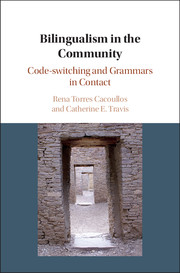Book contents
- Bilingualism in the Community
- Bilingualism in the Community
- Copyright page
- Dedication
- Contents
- Figures
- Tables
- Acknowledgments
- 1 Language Contact Through the Lens of Variation
- 2 The Community Basis of Bilingual Phenomena
- 3 Good Data: Capturing Language Use
- 4 Characterizing the Bilingual Speaker
- 5 Subject Pronoun Expression: Reconsidering the Constraints
- 6 Cross-language Comparisons: Reconsidering Language Types
- 7 Assessing Change and Continuity
- 8 The Most Intimate Contact: The Bilinguals’ Two Languages
- 9 Code-switching without Convergence
- 10 Code-switching and Priming
- 11 Bilingualism in its Linguistic and Social Context
- Book part
- References
- Index
- References
References
Published online by Cambridge University Press: 23 February 2018
- Bilingualism in the Community
- Bilingualism in the Community
- Copyright page
- Dedication
- Contents
- Figures
- Tables
- Acknowledgments
- 1 Language Contact Through the Lens of Variation
- 2 The Community Basis of Bilingual Phenomena
- 3 Good Data: Capturing Language Use
- 4 Characterizing the Bilingual Speaker
- 5 Subject Pronoun Expression: Reconsidering the Constraints
- 6 Cross-language Comparisons: Reconsidering Language Types
- 7 Assessing Change and Continuity
- 8 The Most Intimate Contact: The Bilinguals’ Two Languages
- 9 Code-switching without Convergence
- 10 Code-switching and Priming
- 11 Bilingualism in its Linguistic and Social Context
- Book part
- References
- Index
- References
- Type
- Chapter
- Information
- Bilingualism in the CommunityCode-switching and Grammars in Contact, pp. 215 - 235Publisher: Cambridge University PressPrint publication year: 2018



